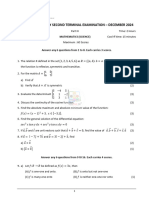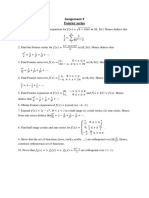Nov 2018
Uploaded by
Dhruv AgarwalCopyright:
Available Formats
Nov 2018
Uploaded by
Dhruv AgarwalOriginal Title
Copyright
Available Formats
Share this document
Did you find this document useful?
Is this content inappropriate?
Copyright:
Available Formats
Nov 2018
Uploaded by
Dhruv AgarwalCopyright:
Available Formats
Reg. No.
III SEMESTER B. TECH END SEMESTER EXAMINATIONS NOVEMBER 2018
SUBJECT: ENGINEERING MATHEMATICS III - [MAT 2103]
(COMMON TO BT/CHE)
Date of Exam: 24.11.2018 Time of Exam: 9.00-12.00 Max. Marks: 50
Instructions to Candidates: Answer ALL the questions
Find the Fourier series expansion of 𝑓(𝑥) = 2𝑥 − 𝑥 2 , 0 < 𝑥 < 2,
1A. 1 𝜋2 4
𝑓 (𝑥 + 2) = 𝑓(𝑥) and hence show that ∑∞
𝑛=1 = .
𝑛2 6
𝑥
Find the half range Fourier Cosine series expansion of 𝑓 (𝑥) = 1 − , 3
1B. 𝑙
0 < 𝑥 < 𝑙. Also draw the graph of corresponding periodic extension of f(x).
1 − 𝑥 2 , |𝑥| ≤ 1
Find the Fourier transform of 𝑓 (𝑥) = { and hence evaluate
0, |𝑥| ≥ 1 3
1C. ∞ sin 𝑡−𝑡 cos 𝑡
∫0 3
𝑑𝑡.
𝑡
a) Obtain first harmonic in the Fourier series of amplitude A
t sec: 0 𝑇⁄ 𝑇⁄ 𝑇⁄ 2𝑇⁄ 5𝑇⁄ T
6 3 2 3 6
2A. A amp: 1.98 1.30 1.05 1.30 -0.88 -0.25 1.98 4
b) Find the bilinear transformation which maps 𝑧 = 0, 1, ∞ to
𝑤 = −5, −1, 3. What are invariant points in this transformation?
1 3
2B. Find the cosine transform of 𝑓(𝑥) = 𝑒 −𝑎𝑥 , 𝑎 > 0 and hence find 𝐹𝑐 { }.
𝑎2 +𝑥 2
If 𝑓 (𝑧) = 𝑢 + 𝑖𝑣 is an analytic function of z=x+iy, show that
2C. 𝜕2 𝜕2 3
( 2
+ 2
) |𝑓 (𝑧)|2 = 4|𝑓 ′ (𝑧)|2 .
𝜕𝑥 𝜕𝑦
sin 2𝑥
3A. Find an analytic function 𝑓 (𝑧) = 𝑢 + 𝑖𝑣 for which 𝑢 = cos 2𝑦+cos 2𝑥 4
1
3B. Find all possible series expansion of 𝑓(𝑧) = 𝑎𝑏𝑜𝑢𝑡 z=0. 3
𝑧 2 +3𝑧+2
𝑧2
3C. Evaluate ∮𝐶 (𝑧+1)(𝑧 2 +4)
𝑑𝑧 where 𝐶: |𝑧 − 2𝑖| = 3. 3
Show that 𝐴⃗ = 𝑟 𝑛 𝑟⃗⃗⃗ is irrotational. Find the value of 𝑛 for which the vector
4A. 𝐴⃗ = 𝑟 𝑛 𝑟⃗⃗⃗ is also solenoidal, where 𝑟⃗ = 𝑥𝑖̂ + 𝑦𝑗̂ + 𝑧𝑘. 4
̂
Find the equation of tangent plane and normal line to the surface 3
4B.
𝑥 2 + 2𝑥𝑦 2 − 3𝑧 3 = 6 at point (1, 2, 1).
MAT 2103 Page 1 of 2
Reg. No.
Evaluate ∯𝑆 𝐴⃗ ∙ 𝑛̂ 𝑑𝑆 where 𝐴⃗ = (2𝑥 − 𝑦)𝑖̂ − 2𝑦𝑗̂ − 4𝑧𝑘̂ and S is the surface
4C. of the region bounded by 𝑥 = 0, 𝑦 = 0, 𝑧 = 0, 𝑧 = 3 and 𝑥 2 + 𝑦 2 = 16 lying 3
in the first octant.
Verify Green’s theorem for ∮𝐶 (𝑥𝑦 + 𝑦 2 )𝑑𝑥 + 𝑥 2 𝑑𝑦, where C is bounded by 3
5A.
𝑦 = 𝑥 and 𝑦 = 𝑥 2 .
5B. Solve 𝑢𝑥 + 𝑢𝑦 = 2(𝑥 + 𝑦)𝑢 by separating the variables. 3
Solve the partial differential equation 𝑢𝑡𝑡 = 𝑐 2 𝑢𝑥𝑥 using the transformations
5C. 𝑣 = 𝑥 + 𝑐𝑡 and 𝑤 = 𝑥 − 𝑐𝑡 subject to the conditions 𝑢(𝑥, 0) = 𝑓 (𝑥) and 4
𝑢𝑡 (𝑥, 0) = 𝑔(𝑥).
MAT 2103 Page 2 of 2
You might also like
- Introduction To Quality Control (MME-4306)No ratings yetIntroduction To Quality Control (MME-4306)20 pages
- Prototyping of User Interfaces For Mobile Applications100% (1)Prototyping of User Interfaces For Mobile Applications169 pages
- General Instructions:: Part-A Has Objective Type Questions and Part - B Has Descriptive Type QuestionsNo ratings yetGeneral Instructions:: Part-A Has Objective Type Questions and Part - B Has Descriptive Type Questions6 pages
- Introduction To Engineering Mathematics I SemNo ratings yetIntroduction To Engineering Mathematics I Sem2 pages
- Engineering Mathematics - III (MAT-ELE-201) RCSNo ratings yetEngineering Mathematics - III (MAT-ELE-201) RCS4 pages
- Hsslive_XII SECOND TERM 2024 SAMPLE QN 2No ratings yetHsslive_XII SECOND TERM 2024 SAMPLE QN 23 pages
- Engineering Mathematics - I Question Bank - Unit1-2No ratings yetEngineering Mathematics - I Question Bank - Unit1-24 pages
- 10.3 Parametric Equations and Calculus(1)No ratings yet10.3 Parametric Equations and Calculus(1)15 pages
- P4 May 23 BATCH RWS (Month 7, January 2023) CH 2, 3, 4, 5, 6 (Up To Ex - 6E) + Supporting MaterialNo ratings yetP4 May 23 BATCH RWS (Month 7, January 2023) CH 2, 3, 4, 5, 6 (Up To Ex - 6E) + Supporting Material4 pages
- 03004-03006-03007 S1-Complex Analysis and Numerical Methods-QPNo ratings yet03004-03006-03007 S1-Complex Analysis and Numerical Methods-QP3 pages
- 2 Hons Mathematics SH-MTH-202-C-4 1654498669626No ratings yet2 Hons Mathematics SH-MTH-202-C-4 16544986696263 pages
- adv maths 02 pp - WAZAELIMUCOM_241227_172940No ratings yetadv maths 02 pp - WAZAELIMUCOM_241227_1729406 pages
- Trigonometric Ratios to Transformations (Trigonometry) Mathematics E-Book For Public ExamsFrom EverandTrigonometric Ratios to Transformations (Trigonometry) Mathematics E-Book For Public Exams5/5 (1)
- Organizing: As A Function of ManagementNo ratings yetOrganizing: As A Function of Management50 pages
- MKT 304 Session 1-IMC - An IntroductionNo ratings yetMKT 304 Session 1-IMC - An Introduction35 pages
- Addressing The Intergenerational Gap Between Grade 6 Pupils and Their Subject Teachers and Its Implication On The Teachers Teaching PerformanceNo ratings yetAddressing The Intergenerational Gap Between Grade 6 Pupils and Their Subject Teachers and Its Implication On The Teachers Teaching Performance38 pages
- The Impact of Millennials' Consumer Behaviour On Global MarketsNo ratings yetThe Impact of Millennials' Consumer Behaviour On Global Markets21 pages
- 2022 - McCarthy - Bathy - Automated High-Resolution Satellite-Derived Coastal Bathymetry MappingNo ratings yet2022 - McCarthy - Bathy - Automated High-Resolution Satellite-Derived Coastal Bathymetry Mapping8 pages
- Diesel Engine Bolt Torques (Metric & English) : 645 and 710 Engines100% (1)Diesel Engine Bolt Torques (Metric & English) : 645 and 710 Engines2 pages
- Alat-Alat Kedokteran Umum Harga (RP) Satuan Jumlah I Uks Kit Terdiri DariNo ratings yetAlat-Alat Kedokteran Umum Harga (RP) Satuan Jumlah I Uks Kit Terdiri Dari4 pages
- Sdoh Paper - Erin Miksztal Madelyn Gagliardi Nico LagranaNo ratings yetSdoh Paper - Erin Miksztal Madelyn Gagliardi Nico Lagrana7 pages
- Radiocrafts: Open Wireless Standards Wireless M-Bus, KNX RF, Zigbee, 6lowpanNo ratings yetRadiocrafts: Open Wireless Standards Wireless M-Bus, KNX RF, Zigbee, 6lowpan44 pages
- MUSIC-LINE-UP-FOR-HOLY-WEEK 2022 (Edited)No ratings yetMUSIC-LINE-UP-FOR-HOLY-WEEK 2022 (Edited)3 pages
- VOLVO EXCAVATOR - Volvo Construction Equipment100% (2)VOLVO EXCAVATOR - Volvo Construction Equipment8 pages


































































































